Although every work in this series was selected because it is (or was at the time of its making) experimental in some way, not all are expressly concerned with exploring the essential properties and technological limits of film and video as media. This program gathers films and videos that do address these concerns and were made during a time of forays by a number of filmmakers and artists from film into video as the experimental medium of choice. Though in the West, video equipment became available to a wide consumer base, as well as artists and experimental filmmakers, as early as 1965, in Eastern Europe, the rise of video as an experimental medium began almost a decade later. Most of the works shown here that mark the transition therefore date to the 1970s and early 1980s and were chosen for their medium self-awareness and engagement with medium specificity. Such a scope for the program was a necessary self-imposed limitation since by the end of the 1980s, video in Eastern Europe, as elsewhere, would become a very widely used and protean moving-image medium used for numerous purposes (including performance art documentation and politically subversive reportage),[1] but not always in experimental ways.
Banner images L to R: Image is Virus, courtesy Dalibor Martinis; Checkmate and Painted in the Air, both courtesy NFD
Medium Experiments: From Film to Video
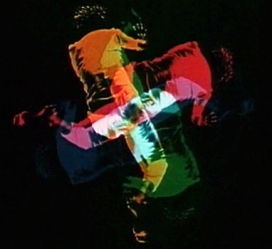
Still from Kwadrat, courtesy Filmoteka Muzeum
Zbigniew Rybczyński’s wonderfully playful film Media from 1980 contemplates this moment of transition. A remarkable technical accomplishment shot on 35 mm, the film depicts a man sitting inside a color television and bouncing back and forth an inflatable ball that floats within another television, this one black and white. In using the medium of film to create the illusion that people and objects on TV are more than mere representations, Media seems to vindicate the older technology and its ability to dazzle. At the same time, the film tacitly acknowledges the power of the “small screen” from which by the 1980s most people received most of their moving images. The film is also a masterpiece in the older sense of the word insofar as it shows off Rybczyński’s mastery in manipulating every moving image medium and technology that has come along in his lifetime.
While still a student, Rybczyński was a member of the Workshop of the Film Form. In 1972, during his studies and as a contribution to the workshop,[2] he made The Square (Kwadrat), his second film represented in the series. Much like Dóra Maurer and Zoltán Jeney’s Kalah, this film also uses 35 mm technology but uncannily prefigures the coming of the digital age, looking into the future past both the rise and the obsolescence of video. Using a mix of photography and animation, Rybczyński made what to modern eyes look like “pixilated” images. The Square thus plays with the basic building blocks of digital imaging, much in the way that Grzegorz Zgraja’s Transformation would reflect on the raster scanning used in video by likening it to the halftone printing process, an analogy that also seems important for the Hungarian director Péter Tímár's 1979 experimental film Raster (Raszter). Both Zgraja and Rybczyński were interested in exploring the basic principles of image reproduction that allow the eye to reconstruct a familiar whole out of abstracted parts. “What is most important about [The Square],” Rybczyński says, “is that not being aware of computer imaging—it was 1970, in Poland—I manufactured my own ‘digital’ processing on film."[3] Similarly, Dóra Maurer spent weeks in a studio editing footage of colorful panels so that they would create a dizzying pattern that matches perfectly a pulsing electronic sound—a task that in the digital age could be completed by a computer using a simple algorithm.
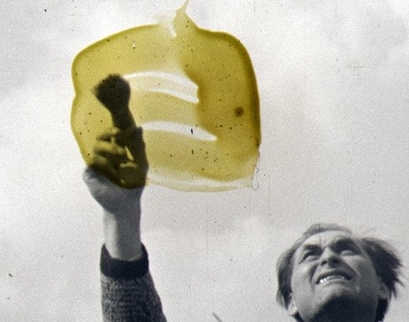
Still from Painted in the Air, courtesy NFD
Two films by Czech filmmakers in this program, Radek Pilař’s 1965 Painting in the Air and Pavel Bárta’s 1983 Checkmate show that film did remain a robust medium for experimentation with its properties well into the 1980s, especially if the films were shot in places where access to video equipment was severely restricted. Despite such limitations, Radek Pilař, whose 1965 film shows humans “interacting” with abstract shapes painted directly onto film stock, became a pioneer of video in Czechoslovakia in the 1980s. So did another Czech filmmaker, Petr Skala, whose two films in the program show how his work changed over time thanks to the advent of video technology. His biography, however, also epitomizes the personal commitment that artistic experimentation could demand under the more repressive socialist regimes. After years of making nonnarrative, abstract films in total solitude for fear of censorship and persecution, in the 1980s, Skala at times risked arrest in order to gain access to state-owned video equipment, which he needed in order to bring to life his changing artistic vision. As Bohdana Kerbachová writes of Skala’s situation in Prague, “Under the totalitarian regime with its strictly controlled media it was very difficult to gain access to the new technology. The options open to Skala brought him on [sic] the brink of breaking the law. One of them was to get hold of the modern technologies, particularly the captioning equipment, owned by the state-controlled Czechoslovak Television. A more viable alternative involved nightly visits to the studio of the Prague Communications High School, which was equipped with a processor for the treatment of electronic image."[4]
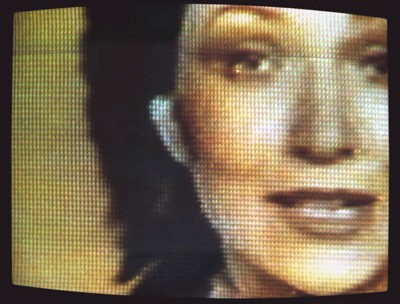
Still from Image is Virus, courtesy Dalibor Martinis
Even in the more liberal socialist states, the access that experimental filmmakers, artists, and amateurs could have to video equipment was uneven. Barbara Borčić has argued that in the 1970s in Yugoslavia, following a larger international trend, video was “perceived as a truly democratic medium” that “promised new artistic models."[5] Yet the expense of professional-quality technology was prohibitive to amateur film clubs, and access to TV studios was restricted and did not become available in Yugoslavia until the early 1980s.[6] Some remarkable interventions by artists into television did occur after that.[7] Sanja Iveković’s Personal Cuts, was made in 1982 for prime-time television and shown on TV Zagreb’s 3, 2, 1—Action! Yet this work, as well as a number of others that Iveković made both by herself and in collaboration with Dalibor Martinis, was deeply suspicious of television’s use of video technology, an attitude also evident in Martinis’ Image Is Virus (1983).[8] Tellingly, two of the three works by Martinis screened in this program, including Image Is Virus, were made abroad (in Canada and the Netherlands), rather than at home.
According to Borčić, of all the major TV studios, TV Belgrade was the most open to collaboration with artists in the 1980s, incorporating video art and even commissioning new works for shows about contemporary art.[9] In Slovenia, too, independent video makers could gain access to video processing equipment and a community—their work can be found in an archive of Video Art in Slovenia, 1969–98, and in the Digital Video Archive. The pioneer of video art in Slovenia, Miha Vipotnik, a number of whose works are archived here, “collaborated with Slovene public television and made numerous art videos, video heads, intros and animations. [He also] directed music and art programs for RTV Ljubljana introducing experimental usage of video technology.” In 1983, Vipotnik cofounded in Ljubljana the International Video Biennial Video CD, which took place until 1987.[10] By the late 1980s, there were independent spaces that allowed access to video processing equipment and multiple video festivals in Yugoslavia. (The major Western European video festivals were founded between 1980 and 1982 in Locarno, the Hague, Bonn, and Montbéliard, as well as at Ars Electronica in Linz.) Barbara Borčić argues that the “ghetto” in which video and conceptual art found themselves in Yugoslavia did not ultimately allow them to have the impact they wanted—but that assessment would probably ring true for artists well beyond Yugoslavia as well.[11]
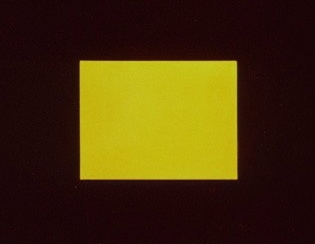
Still from Kalah, courtesy MaNDA Archive
One of the larger histories to which the introduction and experimental use of video technology in Eastern Europe belongs is the history of attitudes and cultural policy surrounding the “experimental” in the arts in the Eastern Bloc. This history as it concerns the use of new technology in music and sound art is narrated exhaustively by David Crowley in the catalog of the exhibition Sounding the Body Electric (2013). Crowley details how from the late 1950s on, “heady rhetoric of technological progress” was “proclaimed throughout the Eastern Bloc after the trauma of Stalinism.” “In the age of the Sputnik, cybernetics and modern telecommunications,” Crowley writes, “science and technology were . . . promoted by the state, most strongly in the Soviet Union but elsewhere in Eastern Europe too. Science could correct the course of socialism. The restoration of reason and technocratic command of high-tech tools would mould new kinds of rational citizens ready for communism."[12]
Amid this upsurge of enthusiasm for technology and its possibilities, musicians, as well as, to some extent, designers, architects, and artists could, as Crowley documents, draw on official resources to create ambitious projects that pushed the boundaries of media and created new, intermedia artistic forms. For electronic music, opportunity came when a number of “experimental” recording studios opened across the Soviet Union and in several other Communist states between 1957 and 1972.[13] “Operating with official imprimatur and, equally importantly, the financial resources needed to buy equipment from abroad, such experimental studios produced new forms of music in Eastern Europe. . . . Despite often being attached to state radio broadcasters or providing sound tracks for television and cinema, these new experimental studios were semi-autonomous zones. . . . New music was—like many areas of culture in Eastern Europe in the 1970s—often a self-regulating field."[14]
As this film series demonstrates, filmmakers, too, experienced a flourishing of opportunities in the late 1950s and 1960s when the founding of professionally equipped experimental film studios and establishment of networks of amateur film clubs gave them much-needed resources. Yet a similar synergy of artistic enthusiasm about the possibilities of the medium and official investment and promotion of it did not happen in most places in Eastern Europe for video, which reached the point of becoming viable as a consumer product in the 1970s,[15] when the intermittent reformism and political optimism of the earlier decades gave way to the desire of the authorities overseeing “real socialism” to maintain the status quo, with television used first and foremost as a tightly controlled ideological too.[16] Writing of the Soviet situation, for example, researchers working on the Screening Socialism project, which traces the history of television in the Eastern Bloc, note: “In its early days, [the popularity of television] brought with it fears about the effect of the medium on viewers, whose passion for television was seen by some critics to be potentially damaging to Soviet cultural ideals. . . . However, by the mid-1960s, . . . there seems to have been a tacit acceptance amongst cultural elites that television was here to stay, and great excitement amongst the political hierarchy about the propaganda potential of the new medium.”
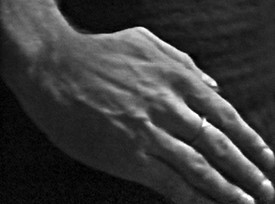
Still from Video A, courtesy Filmoteka Muzeum
Józef Robakowski, one of the core members of the workshop, articulated the group’s position on television eloquently in 1976, writing, “Television . . . the medium that exceeded our sense of the real, amazes with its unlimited potential and impresses with its omnipresence. Used as the most perfect means of human communication . . . it took on the function of expressing the intentions of the people who control this most magnificent discovery of the twentieth century. Video Art opposes and resists the utilitarian character of this institution. It is an art movement that, through its independence, reveals the mechanisms by which human beings may be manipulated and pressured by being told how to live."[17]
Two years earlier, another core member of the group, Paweł Kwiek, went on state-run television, but to make a similar point. As Ronduda writes, “During a show devoted to the Film Form Workshop broadcast by Channel 2 of Polish television, [Kwiek] gave a live performance in front of thousands of viewers, called Sytuacja studia (Studio Situation)” (screened in the program on the Workshop of the Film Form). “Standing in front of the cameras, [Kwiek] gave directions to the cameramen. By directing a television broadcast about himself, he wanted to show the viewers that any attempt to report a given event, any attempt at mass communication, is bound to be deformed by the medium. It is always dependent on interpretation—that is, a construction of new information by the person operating the medium.”[18] Kwiek subsequently made video installations that allowed him to “identify the structure of his own cognition with the structure of a machine.” To explore this idea, as well as his fascination with “the simultaneity in observing the effect and the working cause” of an event, which video allows, Kwiek created video projects, actions, and installations throughout the 1970s. In one 1978 work, Video and Breath (Video i oddech), he created a mechanical link between the knob regulating the brightness of a video image and the movement of his chest, thus controlling the brightness of the image with his breathing and creating an instant feedback loop between the body and the machine which gave that body a new self-awareness.[19]
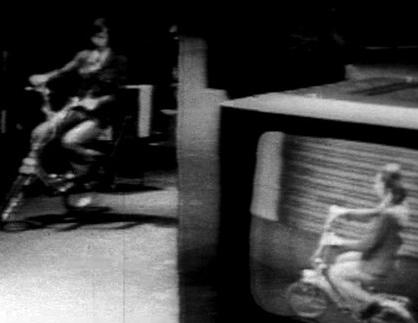
Still from The Space Transmission, courtesy Filmoteka Narodowa
In 1974, the same year that Kwiek made Studio Situation, Wojciech Bruszewski, yet another core WFF member, shot in a TV studio a one-minute video titled The Space Transmission (Transmisja przestrzenna) (also screened in the present series), which was intended as a proof of concept for a new type of filmmaking. In the video, Bruszewski rode a bicycle in a TV studio while three cameras were trained on him. One camera filmed not only Bruszewski but also the monitor feeds of the two other cameras, creating continuity between what the viewer sees as “reality” and its “representation.” Bruszewski, too, thus demonstrated the contingency of any one camera angle as he proposed to create what he called a “spatial film” whose “film structure [would be] close to the chaotic, labyrinthine structure of life with which we have to live while participating in a show called the world.” By proposing such “a continuous, non-manipulated multi-transmission,” Bruszewski, who, according to Łukasz Ronduda, “was probably the first . . . private owner of a video camera and video player in communist Poland . . . investigated the possibility of knowing and describing the material reality beyond human limitations, projections, and fantasies."[20]
The Workshop of the Film Form was dissolved in 1977. Three years later, in 1980, its former members turned their attention to an expressly political concern, working to reform the Leon Schiller National Higher School of Film, Television, and Theater (also referred to elsewhere in this web feature as the Łódź Film School). They also organized an exhibition the same year in collaboration with the Łódź office of the oppositional Solidarity movement. With the introduction of martial law in Poland in December 1981, the group’s activities were halted. According to Ronduda, however, “Toward the end of the 1970s, the Laboratorium Technik Prezentacyjnych (Laboratory of Presentational Technologies), whose members were Grzegorz Zgraja, Krzysztof Zgraja, Jadwiga Singer, Jacek Singer, Zygmunt Rytka, and Tomasz Sikorski, took up the model of analytical art proposed by the Workshop, related to such media as film and video."[21] In 1989, the establishment of the WRO new media festival in Wrocław made that city a magnet for audiovisual work in electronic media, and it remains one to this day.
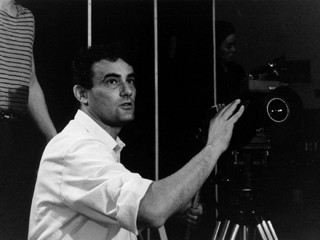
Photograph of Gabor Body by Zoltán Jancsó, courtesy ZKM
In Hungary, Gábor Bódy, the most experimental filmmaker to come out of the Balázs Béla Studio, became interested in video in the 1970s, as can be seen in the final part of his 1975 film Four Bagatelles. There, Bódy delivers a lecture on the infinite mirror-tube, illustrating it with what was, according to Miklós Peternák, “the first Hungarian video piece.” Between 1980 and his death in 1985, Bódy worked with video extensively. Several of his videos can be found here; a DVD with all of Bódy’s video works was released in 2012 as part of an exhibition that drew parallels between Bódy and Zbigniew Rybczyński as two important media innovators from the former East.
In 1980–81 Bódy started to draft and in 1982 released, while living in Germany, the first edition of Infermental, “the first international videocassette magazine,” which continued its existence until 1991, gathering together a total of 660 works in that time. Notably, when conceiving the magazine, Bódy was already collaborating with Polish artist Józef Robakowski, as well as many other experimental film and video makers from around the world. Bódy conceived Infermental as an “international recorded imagery project,” writing, “In the interest of language’s urge to communicate, expand and extend, experimentation ought to break out of locally based and festival subcultures. What is needed is an international periodical affording the possibility of continuous publication.” The themes that Infermental explored included media research, articulation research, new functions, cult acts, and lexicons.
According to Rudolf Frieling, the magazine “published video artworks in part or whole, trailers, and reports (lasting 1–20 minutes) from around the world. Appearing annually with a total running time between four and six hours, each issue was compiled and edited in a different worldwide location.” Released on easily distributed cassette tapes, Infermental could then be shown in any number of venues. After compiling the first edition, Bódy let others edit subsequent issues, including fellow Hungarians. László Beke and Péter Forgács, who edited Infermental III in 1984. The complete magazine archive has been on permanent loan to the collection of the ZKM Karlsruhe since 1992, and it remains an important testament to the promise video held out in the 1980s as a moving image technology that could connect people and cross boundaries more easily than ever. Though video art did not begin to be practiced widely in Bódy’s native Hungary until the mid- to late 1980s, it did eventually became a more prominent art form, even inspiring the artist and filmmaker János Sugár to write an opera, The Immortal Culprits (1988), the libretto of which consists largely of detailed explanations of the workings of video equipment. A detailed chronology of the history of video in Hungary has been put online by the C3: Center for Culture & Communication Foundation. — Ksenya Gurshtein
1. For an article on video’s role in revolutions of the late 1980s in Eastern Europe, see Chris Hill, “Where Independent Media Made a Difference: Citizen Producers in Eastern Europe, 1989–1991,” Community Media Review (March–April 1994). (back to top)
2. Łukasz Ronduda, Polish Art of the 70s (Warsaw, 2009), 295. (back to top)
3. Zbigniew Rybczynski, “Looking to the Future—Imagining the Truth,” in Cinema and Architecture: From Historical to Digital, ed. Francois Penz and Maureen Thomas (London, 1997), also reproduced here. (back to top)
4. Bohdana Kerbachová, booklet accompanying the DVD compilation Petr Skala: Utajený Experimentátor [Petr Skala: Hidden experimenter], (Prague, 2005), 37. (back to top)
5. Barbara Borčić cites as evidence “an issue of the Zagreb photography magazine Spot [which] was devoted to video in 1977. Its articles predicted that the medium of video recording would play a remarkable role, generating structural change in thinking, behavior, and methods for perceiving reality, while video works would have great potential in the realm of social change. This was seen as applying to ideological confrontation with the domination of commerce and capital in art. Video was also seen as promoting social solidarity, individual creativity, and the availability of information and knowledge, and questioning the existing hierarchy of values.” Borčić, “Video Art from Conceptualism to Postmodernism,” in Impossible Histories: Historical Avant-Gardes, Neo-Avant-Gardes, and Post-Avant-Gardes in Yugoslavia, 1918–1991, ed. Dubravka Djurić and Miško Šuvaković (Cambridge, MA, 2003), 494. (back to top)
6. Barbara Borčić, “Video Art from Conceptualism to Postmodernism,” in Impossible Histories: Historical Avant-Gardes, Neo-Avant-Gardes, and Post-Avant-Gardes in Yugoslavia, 1918–1991, ed. Dubravka Djurić and Miško Šuvaković (Cambridge, MA, 2003), 494. “Until the mid-1980s the majority of video works were made within the context of television centers while the main television stations in each republic acted as producers or coproducers.” Ibid., 507. At the same time, Borčić argues that in Yugoslavia, artists who “dealt with the technical, structural, and linguistic characteristics of the new medium” were those who had had a background in working with film through the amateur film clubs. Ibid., 500. (back to top)
To get a sense of the resources for the production, distribution, and exhibition of video works available to artists in the United States during the same period, see, e.g., Barbara London, “Video: A Selected Chronology, 1963–1983,” Art Journal 45 (Autumn 1985): 249–62.
7. For a helpful introduction to the broader TV culture in Yugoslavia, see the Screening Socialism research project: http://www.lboro.ac.uk/departments/socialsciences/screening-socialism/television-histories/tvinyugoslavia/. (back to top)
8. This suspicion was, moreover, rooted in personal experience—in the early 1970s, both Iveković and Martinis worked for Zagreb Television. Barbara Borčić, “Video Art from Conceptualism to Postmodernism,” in Impossible Histories: Historical Avant-Gardes, Neo-Avant-Gardes, and Post-Avant-Gardes in Yugoslavia, 1918–1991, ed. Dubravka Djurić and Miško Šuvaković (Cambridge, MA, 2003), 501. (back to top)
9. Barbara Borčić, “Video Art from Conceptualism to Postmodernism,” in Impossible Histories: Historical Avant-Gardes, Neo-Avant-Gardes, and Post-Avant-Gardes in Yugoslavia, 1918–1991, ed. Dubravka Djurić and Miško Šuvaković (Cambridge, MA, 2003), 505, 506. (back to top)
10. For more on Vipotnik, see Barbara Borčić, “Video Art from Conceptualism to Postmodernism,” in Impossible Histories: Historical Avant-Gardes, Neo-Avant-Gardes, and Post-Avant-Gardes in Yugoslavia, 1918–1991, ed. Dubravka Djurić and Miško Šuvaković (Cambridge, MA, 2003), 502–4. (back to top)
11. Barbara Borčić, “Video Art from Conceptualism to Postmodernism,” in Impossible Histories: Historical Avant-Gardes, Neo-Avant-Gardes, and Post-Avant-Gardes in Yugoslavia, 1918–1991, ed. Dubravka Djurić and Miško Šuvaković (Cambridge, MA, 2003), 517, 495–96. (back to top)
12. David Crowley and Daniel Muzyczuk, Sounding the Body Electric, exh. cat. (Łódź, 2012), 11. (back to top)
13. David Crowley and Daniel Muzyczuk, Sounding the Body Electric, exh. cat. (Łódź, 2012), 13. (back to top)
14. David Crowley and Daniel Muzyczuk, Sounding the Body Electric, exh. cat. (Łódź, 2012), 15, 17. (back to top)
15. The VHS standard was established in the early 1970s and became widely commercially available by the mid-1970s. (back to top)
16. A small but telling example for the Soviet Union is the case of the Prometheus Institute from the city of Kazan, which brought together artists and electronic engineers to find new aesthetic uses for space-age technologies. The group was founded in 1962 and exists to this day. Its founder and the driving force behind its work, Bulat Galeyev, worked tirelessly to incorporate new technologies into his vision of creating synaesthetic sound-and-light shows and environments. Yet in a 1994 article, he noted, “Until recently, video art was not one of our interests—except for our Electronic Painter installations created in 1975–1980 with conventional color TV sets.” Suggesting the degree of ignorance of the subject in the USSR, he continued, “I had previously been acquainted with video art only through foreign magazines and saw it ‘live’ for the first time in 1989 at the Ars Electronica festival in Linz,” at which point Galeyev got very excited about the medium, producing a number of works in it in the 1990s. Bulat M. Galeyev, “The First Experiments of SKB ‘Prometei’ in Video Art,” Leonardo 27 (1994): 399. According to the Screening Socialism research project [ “Across the late-1950s and early-1960s, television [in the USSR] continued to grow, both in terms of take-up amongst the public (although speed of production of receivers continued to be a problem into the 1960s), and also in terms of the number of stations. . . . In addition to these, a number of ‘amateur’ stations run by enthusiasts cropped up around the country (mirroring the development of radio, both in the Soviet Union and worldwide), before increased government scrutiny of both the quality and ideological content of such broadcasts brought these experiments to an end in the 1960s." (back to top)
17. Quoted in Ronduda, Polish Art of the 70s (Warsaw, 2009), 273. (back to top)
18. Łukasz Ronduda, Polish Art of the 70s (Warsaw, 2009), 285–86. (back to top)
19. Łukasz Ronduda, Polish Art of the 70s (Warsaw, 2009), 287–88. (back to top)
20. Łukasz Ronduda, Polish Art of the 70s (Warsaw, 2009), 289. (back to top)
21. Łukasz Ronduda, Polish Art of the 70s (Warsaw, 2009), 299. (back to top)
